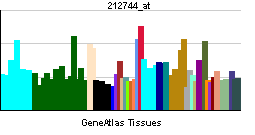BBS4
| Bardet-Biedl syndrome 4 | |||||||||||
|---|---|---|---|---|---|---|---|---|---|---|---|
| Identifiers | |||||||||||
| Symbols | BBS4 ; | ||||||||||
| External IDs | Template:OMIM5 Template:MGI HomoloGene: 13197 | ||||||||||
| |||||||||||
| RNA expression pattern | |||||||||||
 | |||||||||||
 | |||||||||||
| More reference expression data | |||||||||||
| Orthologs | |||||||||||
| Template:GNF Ortholog box | |||||||||||
| Species | Human | Mouse | |||||||||
| Entrez | n/a | n/a | |||||||||
| Ensembl | n/a | n/a | |||||||||
| UniProt | n/a | n/a | |||||||||
| RefSeq (mRNA) | n/a | n/a | |||||||||
| RefSeq (protein) | n/a | n/a | |||||||||
| Location (UCSC) | n/a | n/a | |||||||||
| PubMed search | n/a | n/a | |||||||||
Bardet-Biedl syndrome 4, also known as BBS4, is a human gene.[1]
This gene encodes a protein which contains tetratricopeptide repeats (TPR), similar to O-linked N-acetyglucosamine transferase. Mutations in this gene have been observed in patients with Bardet-Biedl syndrome type 4. The encoded protein may play a role in pigmentary retinopathy, obesity, polydactyly, renal malformation and mental retardation.[1]
References
Further reading
- Haftek J, Krawczykowa Z, Stankiewicz A; et al. (1975). "[Ocular manifestations in orbital fractures]". Klinika oczna. 45 (6): 655–9. PMID 1138127.
- Carmi R, Rokhlina T, Kwitek-Black AE; et al. (1995). "Use of a DNA pooling strategy to identify a human obesity syndrome locus on chromosome 15". Hum. Mol. Genet. 4 (1): 9–13. PMID 7711739.
- Bruford EA, Riise R, Teague PW; et al. (1997). "Linkage mapping in 29 Bardet-Biedl syndrome families confirms loci in chromosomal regions 11q13, 15q22.3-q23, and 16q21". Genomics. 41 (1): 93–9. doi:10.1006/geno.1997.4613. PMID 9126487.
- Mykytyn K, Braun T, Carmi R; et al. (2001). "Identification of the gene that, when mutated, causes the human obesity syndrome BBS4". Nat. Genet. 28 (2): 188–91. doi:10.1038/88925. PMID 11381270.
- Katsanis N, Eichers ER, Ansley SJ; et al. (2002). "BBS4 is a minor contributor to Bardet-Biedl syndrome and may also participate in triallelic inheritance". Am. J. Hum. Genet. 71 (1): 22–9. PMID 12016587.
- Riise R, Tornqvist K, Wright AF; et al. (2002). "The phenotype in Norwegian patients with Bardet-Biedl syndrome with mutations in the BBS4 gene". Arch. Ophthalmol. 120 (10): 1364–7. PMID 12365916.
- Strausberg RL, Feingold EA, Grouse LH; et al. (2003). "Generation and initial analysis of more than 15,000 full-length human and mouse cDNA sequences". Proc. Natl. Acad. Sci. U.S.A. 99 (26): 16899–903. doi:10.1073/pnas.242603899. PMID 12477932.
- Hoskins BE, Thorn A, Scambler PJ, Beales PL (2004). "Evaluation of multiplex capillary heteroduplex analysis: a rapid and sensitive mutation screening technique". Hum. Mutat. 22 (2): 151–7. doi:10.1002/humu.10241. PMID 12872256.
- Ota T, Suzuki Y, Nishikawa T; et al. (2004). "Complete sequencing and characterization of 21,243 full-length human cDNAs". Nat. Genet. 36 (1): 40–5. doi:10.1038/ng1285. PMID 14702039.
- Kim JC, Badano JL, Sibold S; et al. (2004). "The Bardet-Biedl protein BBS4 targets cargo to the pericentriolar region and is required for microtubule anchoring and cell cycle progression". Nat. Genet. 36 (5): 462–70. doi:10.1038/ng1352. PMID 15107855.
- Gerhard DS, Wagner L, Feingold EA; et al. (2004). "The status, quality, and expansion of the NIH full-length cDNA project: the Mammalian Gene Collection (MGC)". Genome Res. 14 (10B): 2121–7. doi:10.1101/gr.2596504. PMID 15489334.
- Ye X, Dai J, Fang W; et al. (2005). "Cloning and characterization of a splice variant of human Bardet-Biedl syndrome 4 gene (BBS4)". DNA Seq. 15 (3): 213–8. PMID 15497446.
- Rual JF, Venkatesan K, Hao T; et al. (2005). "Towards a proteome-scale map of the human protein-protein interaction network". Nature. 437 (7062): 1173–8. doi:10.1038/nature04209. PMID 16189514.
| This protein-related article is a stub. You can help Wikipedia by expanding it. |